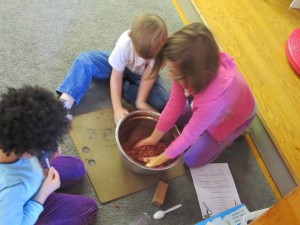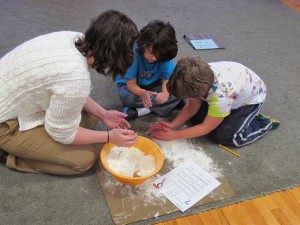Students in grades K-2 explored the states of matter: solids, liquids, and gases, with our student teacher, Taylor. Students began with solids. They worked in groups and were each given a “mystery object” in a paper bag. Without looking and just using just their hands, students had to feel their object and use descriptive words to describe what their object felt like. Students used words such as smooth, hard, rough, circular, etc. Students then learned that all of their objects were solids and that solids are objects that have their own shape and can be held in your hand. Then students had to go around the room and find 5 different solids to share with the class and be able to tell us why their objects were solids.
We then moved on to liquids. Students were assigned a partner and a station that had a container filled with a specific liquid. The different liquids they would work with included: fabric softener, laundry detergent, plain water, colored water, corn syrup, cooking oil, and hand soap. Working with their partners, students had to determine what properties their liquid had. The properties were discussed before the activity began and included: colored, transparent, viscous, translucent, bubbly, or foamy. Students had to make sure they understood especially what viscous was, what the different between transparent and translucent was, and how to tell if something is bubbly or foamy. After we reviewed these terms, students had 2 minutes to visit each liquid station.
 To learn about gases, students first discussed what they thought a gas was. Can you hold it? Can you see it? Examples of gases? Then they watch the teacher blow up a balloon using a plastic bottle, vinegar and baking soda. It was really cool! Then students were able to explore gases on their own. With a partner, students were given a bowl of water, a plastic cup, and a paper towel. First students had to predict what they thought would happen if they put a paper towel at the bottom of the plastic cup and then place the cup straight down into the water. Would the paper towel be wet or dry? Students made their predictions and then worked with their partner to do the experiment. A few paper towels dropped so the experiment had to be done a couple times until students got their paper towels to stay. Students soon discovered that the paper towel stays dry because water cannot get into the cup because there is air in the cup. That’s how we know there is gas!
To learn about gases, students first discussed what they thought a gas was. Can you hold it? Can you see it? Examples of gases? Then they watch the teacher blow up a balloon using a plastic bottle, vinegar and baking soda. It was really cool! Then students were able to explore gases on their own. With a partner, students were given a bowl of water, a plastic cup, and a paper towel. First students had to predict what they thought would happen if they put a paper towel at the bottom of the plastic cup and then place the cup straight down into the water. Would the paper towel be wet or dry? Students made their predictions and then worked with their partner to do the experiment. A few paper towels dropped so the experiment had to be done a couple times until students got their paper towels to stay. Students soon discovered that the paper towel stays dry because water cannot get into the cup because there is air in the cup. That’s how we know there is gas! After learning about each state individually, students then worked with materials such as flour, kidney beans, cornmeal, and rice to determine if these materials were solids or liquids. Using funnels, spoons, cups, and blocks, students filled out a worksheet in order to make a guess as to whether their material was a solid or a liquid. Many of the materials act as liquids but all of them are in fact just very small solids!
In the final class, students experimented with changing states of matter. Students first discussed what atoms are and learned that atoms are very small particles that make up everything! Students were assigned to be either a solid atom, a liquid atom, or a gas atom and had to act as that atom along to music. The solids stood very close together and wiggled, the liquid atoms danced and shook each other’s hands, and the gas atoms danced far apart but did not touch. Then the music got faster and some students were hit with a red strip of paper representing heat and changed states. Then the music got slow and some students were hit with a blue strip representing cooling and changed states. After each round of music, students discussed what the red or blue strips represented and how they changed if they were a solid, liquid, or gas.
This class was really fun and engaging and students really enjoyed themselves!
